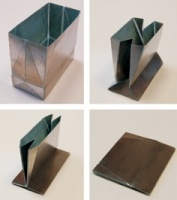The project started off as a mathematical curiosity for Dr Zhong You, a lecturer at Oxford’s Department of Engineering Science, but it may have important implications for the packaging industry.
Many consumer products are packed in cartons made of rigid sheet materials less flexible than paper. Typically, these cartons are box shaped, made with both the top and bottom open to allow flat packing, with the base being assembled separately.
‘This can be quite laborious, in particular if you are moving house and using cardboard boxes, but even more so on the factory assembly line,’ said You, adding that a solution could speed up automated packing in many industries.
Indeed, the challenge of making a rigid, open-topped cardboard box that can be folded flat without having to open its bottom is a long-standing one.
In 2004, a mathematician from the Massachusetts Institute of Technology (MIT) proposed a theoretical solution to the problem; however, the formula specified an infinitely thin sheet material and so could never be practically made. You, a civil engineer by training, used his experience of making models to tackle the problem.
‘I came from a background working on foldable structures, and the thing is, you can claim computationally everything works, but people still like to see if you can actually make them — that’s why all my work has physical, real models, no matter whether they are small or big.’
The prototype was made from stainless steel plates stuck to a plastic sheet, where the edges of the plates serve as creases along which to fold.

You said he was now in consultation with carton manufacturers, but the work could have even wider implications. Origami has already inspired foldable solar cells for use in space that can be packaged into a small area on board a space shuttle.
The goal for civil engineers would be a building that could be reconfigured according to requirements of the occupant as well as, for example, a kitchen that has counters that can be folded away.
You told The Engineer that his team had been looking at folding squash courts for international competitions — which are essentially transparent glass boxes allowing spectators to see the action — as well as foldable cycle helmets.
‘There are two things that come in handy here: one, the thing can be folded smaller for when it’s not being worn; and two, it would be good if the expanded shape could absorb shock, and origami tends to have this as it can deform and take the impact.’




April 1886: the Brunkebergs tunnel
First ever example of a ground source heat pump?